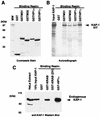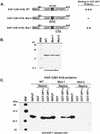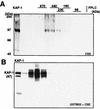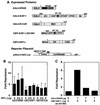KAP-1 corepressor protein interacts and colocalizes with heterochromatic and euchromatic HP1 proteins: a potential role for Krüppel-associated box-zinc finger proteins in heterochromatin-mediated gene silencing
- PMID: 10330177
- PMCID: PMC104396
- DOI: 10.1128/MCB.19.6.4366
KAP-1 corepressor protein interacts and colocalizes with heterochromatic and euchromatic HP1 proteins: a potential role for Krüppel-associated box-zinc finger proteins in heterochromatin-mediated gene silencing
Abstract
Krüppel-associated box (KRAB) domains are present in approximately one-third of all human zinc finger proteins (ZFPs) and are potent transcriptional repression modules. We have previously cloned a corepressor for the KRAB domain, KAP-1, which is required for KRAB-mediated repression in vivo. To characterize the repression mechanism utilized by KAP-1, we have analyzed the ability of KAP-1 to interact with murine (M31 and M32) and human (HP1alpha and HP1gamma) homologues of the HP1 protein family, a class of nonhistone heterochromatin-associated proteins with a well-established epigenetic gene silencing function in Drosophila. In vitro studies confirmed that KAP-1 is capable of directly interacting with M31 and hHP1alpha, which are normally found in centromeric heterochromatin, as well as M32 and hHP1gamma, both of which are found in euchromatin. Mapping of the region in KAP-1 required for HP1 interaction showed that amino acid substitutions which abolish HP1 binding in vitro reduce KAP-1 mediated repression in vivo. We observed colocalization of KAP-1 with M31 and M32 in interphase nuclei, lending support to the biochemical evidence that M31 and M32 directly interact with KAP-1. The colocalization of KAP-1 with M31 is sometimes found in subnuclear territories of potential pericentromeric heterochromatin, whereas colocalization of KAP-1 and M32 occurs in punctate euchromatic domains throughout the nucleus. This work suggests a mechanism for the recruitment of HP1-like gene products by the KRAB-ZFP-KAP-1 complex to specific loci within the genome through formation of heterochromatin-like complexes that silence gene activity. We speculate that gene-specific repression may be a consequence of the formation of such complexes, ultimately leading to silenced genes in newly formed heterochromatic chromosomal environments.
Figures












Similar articles
-
SETDB1: a novel KAP-1-associated histone H3, lysine 9-specific methyltransferase that contributes to HP1-mediated silencing of euchromatic genes by KRAB zinc-finger proteins.Genes Dev. 2002 Apr 15;16(8):919-32. doi: 10.1101/gad.973302. Genes Dev. 2002. PMID: 11959841 Free PMC article.
-
Targeting of Krüppel-associated box-containing zinc finger proteins to centromeric heterochromatin. Implication for the gene silencing mechanisms.J Biol Chem. 2001 Apr 27;276(17):14222-9. doi: 10.1074/jbc.M010663200. Epub 2001 Jan 19. J Biol Chem. 2001. PMID: 11278721
-
Molecular determinants for targeting heterochromatin protein 1-mediated gene silencing: direct chromoshadow domain-KAP-1 corepressor interaction is essential.Mol Cell Biol. 2000 Sep;20(17):6449-65. doi: 10.1128/MCB.20.17.6449-6465.2000. Mol Cell Biol. 2000. PMID: 10938122 Free PMC article.
-
[KAP-1, a scaffold protein in transcription regulation].Yi Chuan. 2007 Feb;29(2):131-6. doi: 10.1360/yc-007-0131. Yi Chuan. 2007. PMID: 17369165 Review. Chinese.
-
The heterochromatin protein 1 (HP1) family: put away a bias toward HP1.Mol Cells. 2008 Sep 30;26(3):217-27. Epub 2008 Jul 30. Mol Cells. 2008. PMID: 18664736 Review.
Cited by
-
Distinct roles of KAP1, HP1 and G9a/GLP in silencing of the two-cell-specific retrotransposon MERVL in mouse ES cells.Epigenetics Chromatin. 2013 Jun 4;6(1):15. doi: 10.1186/1756-8935-6-15. Epigenetics Chromatin. 2013. PMID: 23735015 Free PMC article.
-
Chromatin remodeling, DNA damage repair and aging.Curr Genomics. 2012 Nov;13(7):533-47. doi: 10.2174/138920212803251373. Curr Genomics. 2012. PMID: 23633913 Free PMC article.
-
All in the family: the BTB/POZ, KRAB, and SCAN domains.Mol Cell Biol. 2001 Jun;21(11):3609-15. doi: 10.1128/MCB.21.11.3609-3615.2001. Mol Cell Biol. 2001. PMID: 11340155 Free PMC article. Review. No abstract available.
-
Heterochromatin and the molecular mechanisms of 'parent-of-origin' effects in animals.J Biosci. 2016 Dec;41(4):759-786. doi: 10.1007/s12038-016-9650-9. J Biosci. 2016. PMID: 27966495 Review.
-
The methyltransferase Suv39h1 links the SUMO pathway to HP1α marking at pericentric heterochromatin.Nat Commun. 2016 Jul 18;7:12224. doi: 10.1038/ncomms12224. Nat Commun. 2016. PMID: 27426629 Free PMC article.
References
-
- Albagli O, Dhordain P, Deweindt C, Lecocq G, Leprince D. The BTB/POZ domain: a new protein-protein interaction motif common to DNA- and actin-binding proteins. Cell Growth Differ. 1995;6:1193–1198. - PubMed
-
- Auble D T, Hansen K E, Mueller C G, Lane W S, Thorner J, Hahn S. Mot1, a global repressor of RNA polymerase II transcription, inhibits TBP binding to DNA by an ATP-dependent mechanism. Genes Dev. 1994;8:1920–1934. - PubMed
Publication types
MeSH terms
Substances
Grants and funding
LinkOut - more resources
Full Text Sources
Other Literature Sources
Molecular Biology Databases
Miscellaneous
